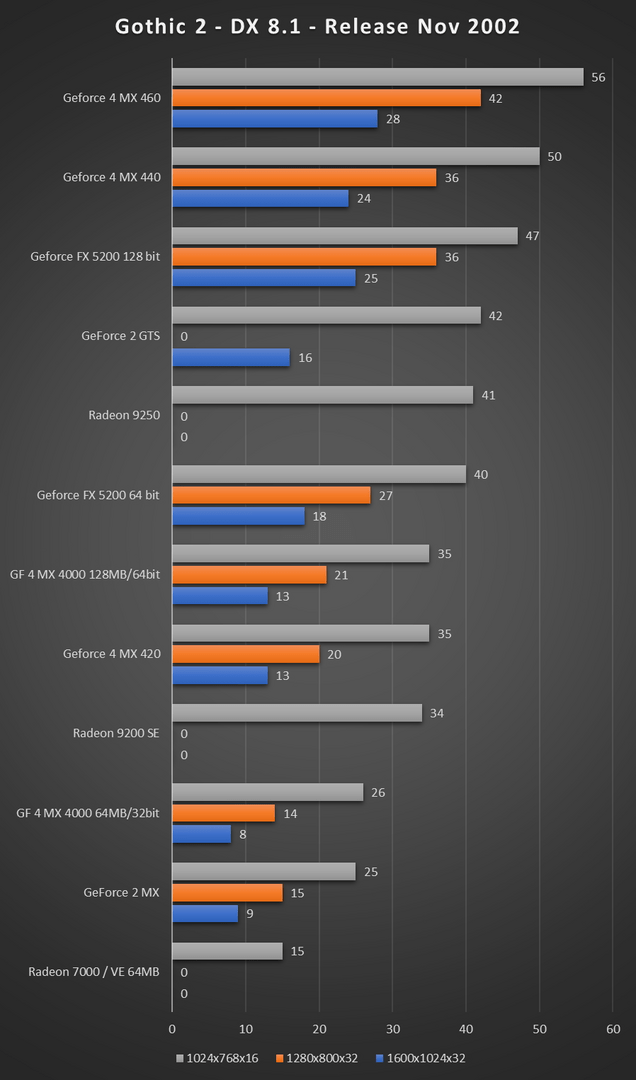In February 2002, Nvidia presented the GeForce 4 series, one of the most commercially successful graphics card series to date, and at the end of 2003, the GeForce 4 MX 4000 was a small OC miracle based on the around 81 million transistors strong NV18 graphics processor manufactured in 150 nm.
GeForce 4 series served two segments
< p class="p text-width">Within the two segments MX – for mainstream models – and Ti – for high-end models – from February 2002 the order of performance was marked with a three or four-digit number. Then as now, a higher number usually meant a more powerful graphics chip or a faster graphics card, which originally resulted in the following portfolio for the GeForce 4 series:
- GeForce 4 MX 420
- GeForce 4 MX 440 SE
- GeForce 4 MX 440
- GeForce 4 MX 460
- GeForce 4 Ti 4200
- GeForce 4 Ti 4400
- GeForce 4 Ti 4600
- GeForce 4 Ti 4800 SE
- GeForce 4 Ti 4800
A few variants with AGP 8x support were added shortly afterwards, but with the release of the subsequent GeForce FX series (reader test) in March 2003, the history of the GeForce 4 came to an end for the time being.
So the NV18 graphics chip – i.e. the GeForce 4 MX with AGP 8x support – was pulled out of its grave again and named MX 4000.
_chiller_, community member
Since the Nvidia GeForce MX 4000 introduced at the end of 2003 is now available on eBay for prices starting at 10 euros, community member “_chiller_” decided to conduct a reader test, which reveals a little overclocking miracle.
- [Reader test] GeForce 4 MX 4000: The almost forgotten latecomer
In the following test system, the Asus V9400MAGIC, a GeForce 4 MX 4000 with 128 MB DDR166 on a 64-bit memory interface, and the Asus V9400X, a GeForce 4 MX 4000 with 64 MB DDR200 on a 32-bit memory interface.
 Nvidia GeForce 4 MX 4000 (image: community member “_chiller_”)
Nvidia GeForce 4 MX 4000 (image: community member “_chiller_”) Nvidia GeForce 4 MX 4000 (Image: Community member “_chiller_”)
Nvidia GeForce 4 MX 4000 (Image: Community member “_chiller_”)- * OC by increasing the clock rate of the interface between the processor and the Northbridge to 290 MHz, the so-called Front Side Bus (FSB)
- connected via IDE adapter
Spoilers:The GPU clock could be overclocked up to 344 MHz (+38%) and the graphics memory up to 290 MHz (+75%). Values that seem almost absurd with today's modern hardware.
 The Nvidia GeForce 4 MX 4000 as an OC wonder (Image: Community member “_chiller_”)
The Nvidia GeForce 4 MX 4000 as an OC wonder (Image: Community member “_chiller_”) In his detailed reader's article, the author delivers numerous results from synthetic benchmarks such as 3DMark 2000, 3DMark 2001 SE, 3DMark 2003 and Aquamark and games such as Gothic 2, Jedi Knight 3 and Unreal 2 and compares the GeForce 4 MX 4000 with the following graphics cards.< /p>
- Radeon 7000
- Radeon 9200SE
- Radeon 9250
- GeForce 2 MX
- GeForce 2 GTS
- GeForce 4 MX 420
- GeForce 4 MX 460
- li>GeForce FX 5200
Differently configured and clocked models were also used here.
 Unreal 2 (Image: Community member “_chiller_”)
Unreal 2 (Image: Community member “_chiller_”) Gothic 2 ( Image: Community member “_chiller_”)
Gothic 2 ( Image: Community member “_chiller_”)Further game benchmarks can be found directly in the reader's article, and the author has also written down his observations on each game.
Feedback expressly desired
As always, questions and suggestions as well as praise and criticism of the reader's article in the comments to this message and in the forum are expressly welcome.
Give me the hints!
In the “From the community” category, the editors repeatedly focus on interesting reader articles from the ComputerBase forum.
The following reader articles from the ComputerBase forum have recently been published secured a place on the start page:
- The A320 home cockpit
- Nvidia GeForce FX 5200 in the reader test
- Ryzen 7 1700X and two Xeon X5460 in a CPU duel
- First-hand reports on the Steam Deck directly from players
- Mini-ITX power dwarf: Radeon RX 6900 XT and Ryzen 9 5950X under water
- K7 and Voodoo²: A journey back in time to the old days of hardware
- AMD, Intel and Nvidia: The ideal gaming PC has been modernized
In order to be able to report more frequently and more up-to-date on new developments and projects from the community in the future, the editors always ask for information in the thread “From the community: Your indications of interest ante reader article”.